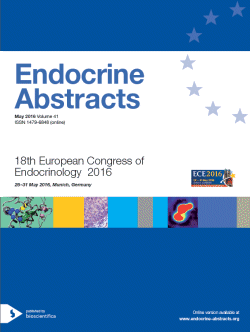Searchable abstracts of presentations at key conferences in endocrinology
Symposia
Genetics and epigenetics of testicular failure
ea0041s17.1 | Genetics and epigenetics of testicular failure | ECE2016
Aberrations on the X-chromosome as cause of male infertility
Infertility affects 1015% of couples and the causes of couple infertility are equally attributed to male and female (co-)factors. Male infertility is a genetically and clinically highly heterogeneous disease with a multitude of up to 1,500 genes supposedly involved in spermatogenesis. Thus, unravelling the underlying causes and the pathophysiology is challenging and candidate gene approaches, e.g. picking one or several genes known to cause infertility in mice, did not i...
ea0041s17.2 | Genetics and epigenetics of testicular failure | ECE2016
Gene variants modulating testicular function
Determinants of male reproductive system are highly complex. The palette of genetic variants modulating testicular function and fertility potential, are expected to be heterogenous. Our team has exploited complimentary study designs to provide novel insights and robust data on the contribution of genetic variation to testicular physiology and risk to impaired fertility in men. Firstly, I discuss our discovery studies utilizing the candidate gene approach and focusing on gonado...
ea0041s17.3 | Genetics and epigenetics of testicular failure | ECE2016
SEMA3A and SEMA3E: from mice to Kallmann syndrome
Gonadotropin releasing hormone neurons are a small group of scattered hypothalamic neuroendocrine cells that control reproductive functions in all mammals and many vertebrates.Despite their position in the adult hypothalamus, during development they originate in the nasal placode and migrate along the vomeronasal nerve to reach the forebrain and attain their final position in the hypothalamus. Failure of GnRH neurons to migrate lead to Kallmann Syndrome,...




